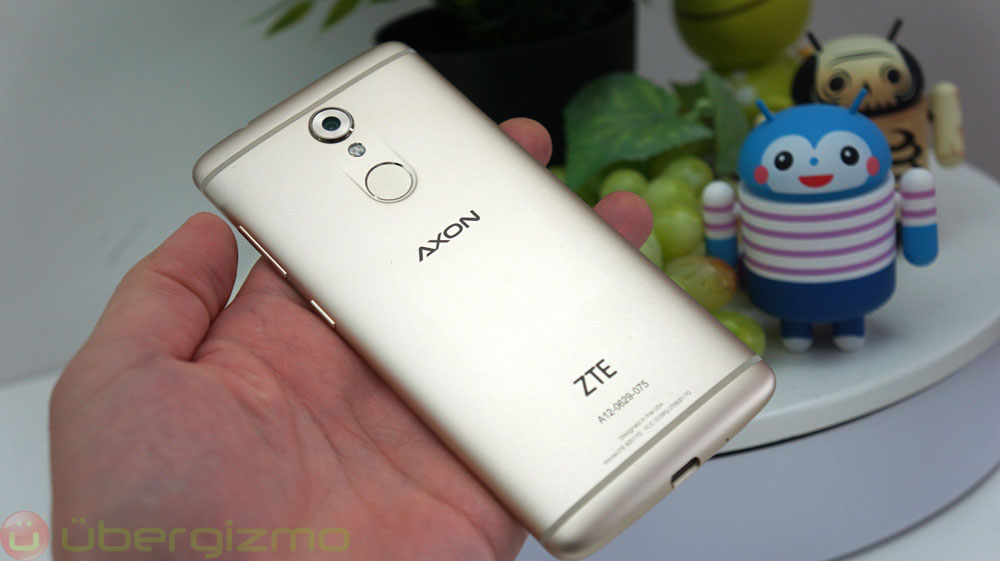ZTE Axon 7 mini: Hands-On

Obviously, ZTE isn’t new to the market and its products spans from infrastructure to handsets. It is large enough and has deep enough pockets to study the likes of OnePlus or Xiaomi, and take the fight to them. The Axon line of product competes directly on that extremely competitive market.
Design

To do so, ZTE has built an all-aluminum unibody with no edges. It is something that popular phones such as the LG G5 have done successfully, and it’s true that the lack of edges is agreeable when holding the handset in your hand. The particular unit we played with was a “gold” model, but there are other options in case you are wondering.
ZTE has worked with Designworks (a BMW subsidiary) on the design, which pushes the “no edge” idea to the point of using 2.5D glass, which is a beveled glass for the display.
Audio
While this is a good thing, better Audio has been historically a tough sell. HTC has been trying to promote this for a while, and LG is somewhat pushing Hi-Fi too. At the moment, I think that most people consider this a “nice to have” but there’s a lot of education and promotion that is needed before Hi-Fi becomes a sway factor in a purchase.
Display
System hardware
The Axon 7 mini is powered by a Snapdragon 617 SoC which features two groups of 4 cores each. Using the big.LITTLE technology from ARM, each group of cores is designed for a different power level: high-performance or low-power. They can switch in and out as the OS deem it appropriate. If there is a massively parallel CPU workload they can all be turned on at once, although it’s not a realistic scenario.
There’s 3GB of RAM, which is pretty decent for multitasking. Keep in mind that the more RAM there is, and the less likely the system will have to access the Flash storage, which is not as fast. The less RAM and the more likely the handset might become sluggish if there is a background task running, or while switching apps.
Battery
The 2705 mAh battery capacity is good, but not impressive in absolute terms. We would need to know the final price to see what battery capacity you get for each dollar spent. ZTE says that the phone can charge from 0% to 46% within 30 minutes (we haven’t tested this ourselves). This means that it charges at a speed of 41 mAh/min, which is considered to be “fast charging”. However, the fastest phones can top 50 to 54 mAh/min in our tests.
Interestingly enough, ZTE says that its Axon 7 phone can charge to 83% in 30mn, which would lead to an unbelievable speed of 90mAh/min, which we have yet to see in the real world, so I would be cautious in until we can measure this ourselves.
Camera
Conclusion
In conclusion, the ZTE Axon 7 mini will probably push the Axon brand down to the ~$300 level, and it is a very good spot to aim at. At this price point, the obvious competition would be the Google Nexus 5, the Sony XPERIA Z3+ and HTC One M9 and all of those have very good user reviews. It looks like a good topic for research.
You May Also Like
Popular Right Now
- Lenovo Legion Y700 Gen 4 Launches With Snapdragon 8 Elite And 165Hz Display
- WhatsApp Introduces Voice Chats For All Groups, Inspired By Telegram
- Volonaut Airbike: Lightweight Flying Superbikes With Jet Propulsion Unveiled
- Flappy Bird Is Back! After 10 Years, It Brings A New Game Experience
- Google Messages Rolls Out On-Device Nudity Detection With Sensitive Content Warnings
- Google AI Mode Adds Multimodal Search To Mobile App
- Leaked Apple Watch Series 10 Prototype Reveals Unique Health Sensor And Potential Future Features
- Canon Unveils PowerShot V1 And EOS R50 V: Best New Vlogging Cameras For 2025
- Bill Gates Predicts: AI Will Replace Doctors And Tutors Within A Decade
- First Shutdown of Niagara Falls in 12,000 Years: A Rare Sight to Behold
- Former Google Engineer claims that humans will achieve immortality soon
- Romotow: The Foldable Camping Trailer Inspired By A USB Flash Drive
- LYRA: Swiss Startup Unveils AR Smart Glasses for Office Work, City Life, And Traveling
- Man Caught in China Smuggling $46K Worth of Intel CPUs Wrapped Around His Waist
- iPhone 15 Pro Max may bring thinner bezels than Xiaomi and Samsung’s latest flagships
- OpenAI's new GPT-4 with a "human-level performance" scored up to 93% on SAT exams

